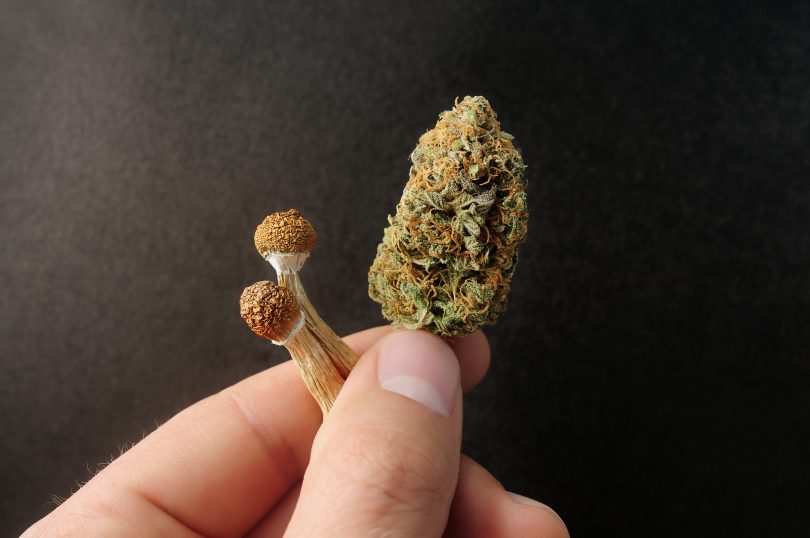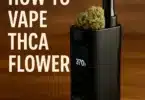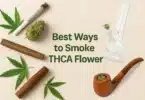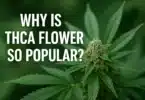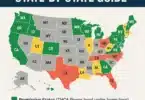Just like cannabis gradually became a regular part of the mainstream conversation during the last decade, over the next few years we can expect to hear much more about psychedelics – everything from medical benefits to legalization efforts, societal views to current studies, and beyond. Given the safe and natural element to using these types of compounds, it’s no surprise that psychedelics are following the same path as cannabis: prohibition, decriminalization and eventual re-legalization on the basis of scientific research and cultural acceptance.
Psychedelic research and legalization is a hot topic right now, and of all the psychedelics, THC is still the most popular one. For all the latest, legal THC products, take a look at our awesome Delta 8 Weekly Newsletter for exclusive deals and more articles like this one.
What are Psychedelics?
Psychedelic drugs are a subset of hallucinogens. They contain psychoactive compounds that are capable of altering a person’s mood, perception, and cognition; sometimes permanently. The active compounds are usually found in nature, like psilocybin or mescaline, but they can also be manmade, like LSD.
Psychedelics are known for causing ‘trips’, which is what the high is referred to. When a person is tripping, they may have altered perceptions of the world around them. Many people believe this is limited to visual and auditory hallucinations, but it can also include feeling, tasting, and smelling things that are not real, as well as a heightened sense of connection and understanding, and greater feelings of introspection.
The trips that people most commonly associate with these types of the drugs are the ones in which a state of hallucinogenic delirium is reached, but that is not always the case. Many times, it is more of an experience than a trip, and something can be learned and achieved psychologically with every small dose.
The word itself, ‘psychedelics’, was first used in 1957 to recognize substances that were said to open the mind, however, the more accurate term for them is ‘entheogens’. This term was adopted, not necessarily for the sake of being scientific, but rather to allow the sector to operate without all the stigma attached to psychedelics from smear campaigns and restrictive policies throughout history. The term entheogen comes from Greek where it means ‘building the god within’.
Different psychedelics produce different trips. For example, with DMT you can expect a short high lasting less than 1 hour, whereas LSD, psilocybin, and mescaline trips can last up to ten hours. Some hallucinogens are more potent than others, like mushrooms vs acid. The active compounds are different in each drug so there is a lot of variation to the effects that can be felt.
Some people experience bad trips in which negative, or even scary, hallucinations are experienced, and/or a rapid heartbeat, sweating, nausea, disorientation, and fatigue occur. There is indication that the majority of these symptoms can be controlled through proper dosing. This is why most modern-day, therapeutic users of psychedelics consume the drugs in micro-doses.
Medical Research on Psychedelics
Just like cannabis, legalization and normalization of psychedelic drugs would be impossible if there weren’t some type of medical benefits to show on paper. Luckily, the research does exist (albeit minimal) – especially in the field of mental health. For example, a study published just last month in the journal Nature Medicine found that MDMA-assisted therapy could be “a potential breakthrough treatment” for post-traumatic stress disorder.
Other studies have looked at psilocybin, the active ingredient in magic mushrooms, as a possible treatment option for clinical depression, and the results were incredibly promising. Additional research is underway to determine the effectiveness of numerous other psychedelics as well, including LSD and ketamine.
Most psychedelics are serotonergic, meaning the interact with the serotonin receptors in our bodies. Many antidepressant drugs involve some type of serotonin signaling, although there are numerous different ways that substances can engage these receptors. Using pharmaceuticals often leaves the patient with many unwanted side effects, whereas natural compounds are typically considered safer, when used correctly.
Psychedelics had a brief stint in modern medicine in the 1950s and several psychologists at the time were utilizing them to treat patients with depression and addiction, LSD in particular. They found it to be especially helpful in curbing alcoholism, which can be proven by this study in which it was reported that even 1 full year after treatment, subjects were still off the booze.
Known as ‘psychedelic therapy’ in the U.S. and ‘psycholytic therapy in the U.K., it was really catching on. However, when these compounds were added to the Schedule 1 narcotics list in both countries, the ability to research psychedelics, let alone utilize them in treatment plans, came to a screeching halt.
In recent years, we’ve seen a massive shift in the way the public, as well as healthcare and government agencies, view this class of drugs. The FDA itself has deemed both psilocybin and MDMA (magic mushrooms and ecstasy) as “leading breakthrough therapies” for depression and PTSD. This means that we can anticipate a surge in research and development for products containing these active ingredients in the very near future.
Psychedelic Legalization Efforts
The heavy regulation of psychedelics began in 1966, just as these drugs started making their way into the realm of recreational use. At the time, ‘recreational’ use of psychoactive substances was rooted in their ability to expand one’s consciousness. Psychedelic activists of today could very well be driven by similar motives, but the focus of their public campaigns is ‘safe, natural, alternative healthcare’ – a topic that many people have been showing greater interest in over the last decade.
Looking at it from a purely legal perspective, it not only makes sense, but it seems like the only logical way to tackle a subject like this one. Pushing for full legalization of highly intoxicating substances is already challenging, for obvious reasons, but if using the argument that our collective consciousness is suffering and in need of expansion, you can imagine that the movement wouldn’t gain much traction (regardless of how true sentiment that actually is).
Psychedelic legalization will undoubtedly face many of the same challenges we have seen time and time again in the fight for cannabis legalization. We know medical research fueled by cultural mainstreaming makes for a remarkably effective weapon against outdated regulations. But despite how far we have come on both of those fronts in the cannabis industry, it remains federally prohibited still. And when looking at our current administration, we know that Joe Biden really has a bug up his you-know-what about cannabis, so it seems incredibly unlikely that we will see any kind of turnaround with psychedelic regulations on his watch.
Nevertheless, we know it’s in the cards and by the end of this decade it will be a booming industry. Numerous, cities, states and countries have already relaxed their laws surrounding possession and use of psychedelics drugs.
Cultural Views on Psychedelic Legalization
Depending on where you live, psychedelics have the unique advantage of being carrying less social stigma than other drugs. Many advocates of psychedelics are healers themselves, dedicated to conserving cultural traditions surrounding the healing of pain and trauma through rituals that include psychedelic use – and this will be a huge contributing factor to eventual legalization.
From their initial emergence into the current cultural discussion, psychedelics have been positioned as a therapeutic drug, rather than recreational; as compounds that you use in micro doses to get only the psychological benefits without any of the psychoactive side effects; and as compounds that will soon be utilized in some of the most cutting-edge therapy sessions, by the most progressive practitioners.
Stigma still exists, as is the case with any intoxicating compound, but much of this stems from completely irrelevant fear; and luckily it’s nowhere as commonplace as it has been for years prior. Most people, even those who generally lean conservative, are adopting more liberal views when it comes to the use of certain substances, especially those that are found in nature. Plant-based healing is a much more popular concept now that in has been in our nation’s recent past.
Looking West
In a big move for the psychedelic industry, a bill was recently passed by a second California Senate committee which would legalize the possession of numerous different forms of psychoactive drugs in the Golden State. The legislation, which was sponsored by Senator Scott Wiener (D), advanced through the Public Safety Committee earlier this month, followed by a pass from the Health Committee one week later. If this bill fully passes, an extensive list of psychedelics including psilocybin mushrooms, DMT, ibogaine, LSD, and MDMA would be legalized for adults aged 21 and older.
Additionally, the bill would call for the expungement of prior convictions for possession of psychedelic drugs, the same way the state is trying to expunge cannabis convictions; as well as redefining what paraphernalia will be lawful to possess and use with these newly legalized substances.
If this all sounds vaguely familiar it’s because California was also the first state to legalize medical cannabis use back in 1996, long before it was a frequently discussed topic in any political discourse. The golden state is also the birthplace of most cultural cannabis trends over the last few decades. California has been at the forefront of cannabis legalization efforts since the early 1970s and is one of the first states to begin expunging prior cannabis-related convictions after Prop 64 passed in 2016.
“The war on drugs has been an abject failure because it is based on the false belief, the false notion, that criminalizing people, arresting them, incarcerating them for possessing, for using drugs, will somehow deter use and improve public safety,” commented democratic Senator Scott Wiener. “It has done neither.”
Oregon, Washington and Colorado are also very liberal states that have been working to change the national narrative on drug use, particularly cannabis and other psychedelics. Oregon became the first state in the United States to decriminalize the possession of all drugs. Possessing heroin, cocaine, methamphetamine and other intoxicating substances for personal use is no longer a criminal offense in Oregon. Those drugs are still against the law, as is selling them. But possession is now a civil – not criminal – violation that may result in a fine or court-ordered therapy, not jail.
Final Thoughts
The path to drug legalization can be bumpy, and taking psychedelics from illegal to medical-use-only to legal for adult-use will take some time. But based on current patterns, we can expect this will happen relatively soon. Just like cannabinoids, psychedelic compounds are the medicine of the future and when legalization does occur, there will be an industry boom like we’ve never seen before.
Thank you for stopping by CBDtesters.co, your #1 spot for the best cannabis-related news globally. Give the site a read-thru daily to stay on top of the exciting world of legal marijuana, and sign up to receive our newsletter, so you never miss a thing. News and deals in your inbox every week!

